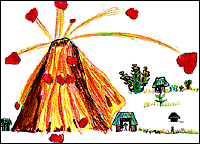

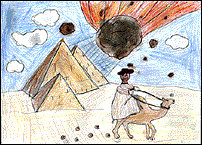
Left: Argh! A meteor hits Giza! (not really) Right: A volcano erupts over El Ceren (really) www.archaeology.org/online/features/godzilla/
Introduction to Archaeology and Palaeoanthropology:
Humanity's Journeys
Dr. Kathryn Denning, Anth 2140, Sept 2005 - Apr 2006
28 Mar 2006
Plan for the day
1 Course business/ announcements...
2 Brief return to Archaeology, ethics, politics
3 Palaeoanthropology, Archaeology, and the Future
Reading and Assignments
Today's readings (Mar 28):
Course Kit: Legacies of Human Evolutionary History
and
The Ends of the World as We Know Them www.truthout.org/docs_05/010205Y.shtml
Godzilla's Attacking Babylon: http://www.archaeology.org/online/features/godzilla/
TOMORROW IN YOUR (LAST) TUTORIAL:
- you'll get your Quiz 6 back and your Museum Assignments
- The last tutorial will be about the future of our civilization. For your last 2% participation assignment: Come with a page of notes (rough is fine) to hand in, on this topic:
Think about the future. Humanity has been on a long journey -- where are we headed next? What are some possible, probable, and preferred futures?
(You could mull this over by thinking about your favourite dystopia or apocalypse story or film (e.g. Brave New World, Gattaca, Godzilla, Blade Runner, 1984, Total Recall, Terminator, the Matrix, the Time Machine, Demolition Man, Mad Max).
Also think back to the start of the year... do you remember wondering what would be left of York 500 or 1000 years from now? What do you think now?
NEXT TUESDAY - last class! No reading (catch up). There will be a final lecture, evaluations, and I will hand out the take-home final exam, which is due April 18.
2 Brief return to Archaeology, ethics, politics
Through cases like 'Kennewick Man', and films like 'Who Owns the Past?', we see that although archaeology has taught us a great deal about human history, this knowledge has come at a great cost. The study of human remains has caused much pain.
Problems include:
- some people's assumptions that they are entitled to study others, without consent
- the assumption that because someone is biologically dead, they are also socially dead / unimportant
- a lack of questioning about exactly how important it is to study some scientific problems
We cannot simply put historical wrongs right.
But there is at least some good news -- repatriation is taking place, and partnerships are being forged between Indigenous peoples and archaeologists.
And it's good news that new ethical standards are emerging in archaeology.
It would be even better news, however, if we really take all that we've learned from archaeology and do something truly positive with it.
Which brings us to...
3 Palaeoanthropology, Archaeology, and the Future
The reading from the course kit, Legacies of Human Evolutionary History (more on this next week) emphasizes that
- we are biocultural creatures
- that despite our success (over 6 billion of us, all over the globe), we are much less successful than, for example, bacteria or insects, and also that - mammals are on the decline, and that we have not actually survived very long yet (200-400 000 years, compared to, for example, Homo erectus, which lasted about 1.5 million years... or other species which have lasted 400 million years)... and most species eventually become extinct
- that we have a serious overpopulation problem
- that we have, historically, had major environmental impacts (e.g. hunting fauna to extinction, environmental degradation), and continue to do so today (e.g. see http://earthobservatory.nasa.gov/Study/footprint/

- but the reading also emphasizes that there are specific goals (UN's Millennium Development Goals) which 150 countries have agreed to support, which will help us and the planet (p 466)
"- eradicate extreme poverty and hunger
- achieve universal primary education
- promote gender equity and empower women
- reduce child mortality
- improve maternal health
- combat HIV/AIDS, malaria, and other diseases
- ensure environmental sustainability
- build a global partnership for development"
Can we do it?
Opinions depend partly on one's view of human nature... which brings us back to history.
Human Nature? Naturally good or bad?

The Story of Easter Island...
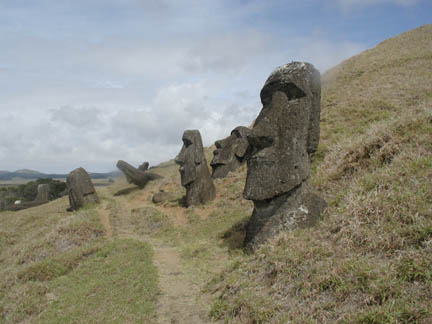
Reading: The Case of Easter Island.
"Easter Island's End", by Jared Diamond, in Discover Magazine, 1995. http://www.hartford-hwp.com/archives/24/042.html
Secrets of Easter Island, NOVA website: http://www.pbs.org/wgbh/nova/easter/index.html
Easter Island Rock Art, by Dr. Georgia Lee: http://www.bradshawfoundation.com/easter/rockart.html
Usual questions about Easter Island / Rapa Nui
"The world that the Europeans first observed when they arrived on Rapa Nui in 1722 has puzzled us for centuries. What was the meaning of the massive stone human statues on the island? How did they transport and erect these multi-ton statues? And, finally, how did the original inhabitants arrive on this remote island?"
http://www.pbs.org/wgbh/nova/easter/index.html
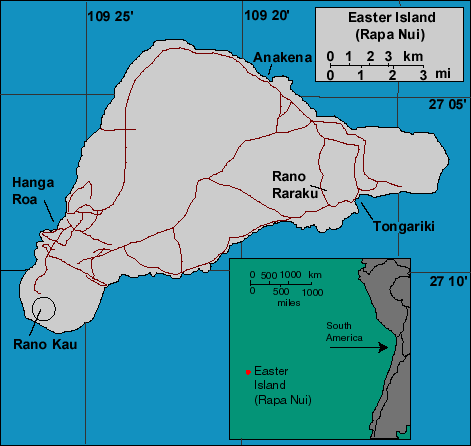
Location as part of Polynesia
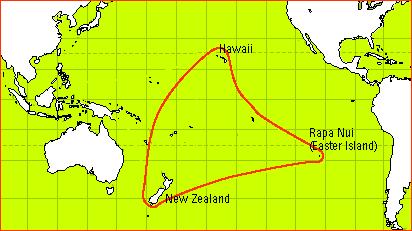

Where are the statues? All around the island.
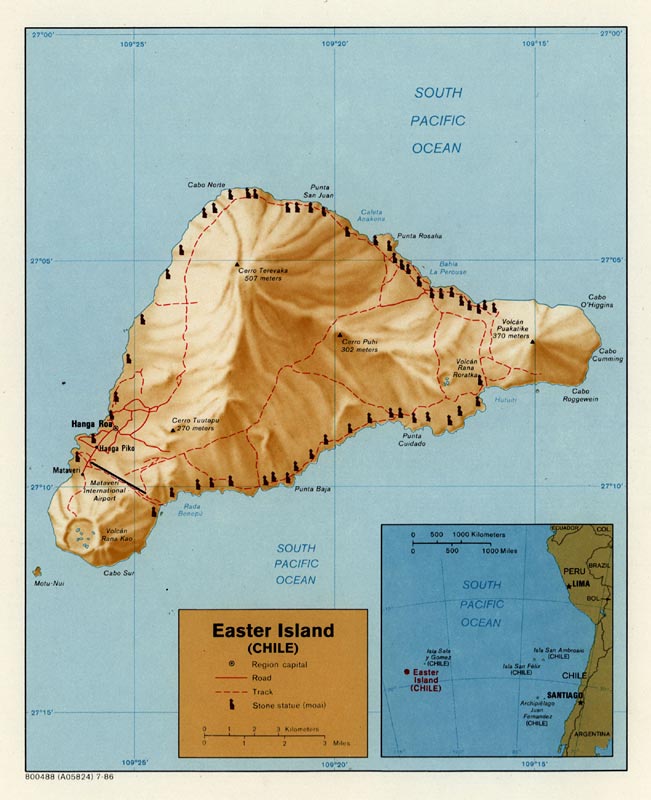
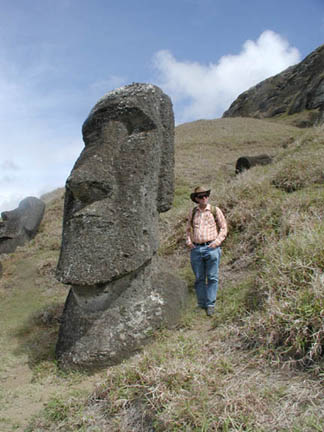

Rano Raraku -- where all the Rapa Nui moai were quarried. These ones never made it to their final destinations elsewhere on the island.
More: http://www.pbs.org/wgbh/nova/easter/explore/ranoraraku.html
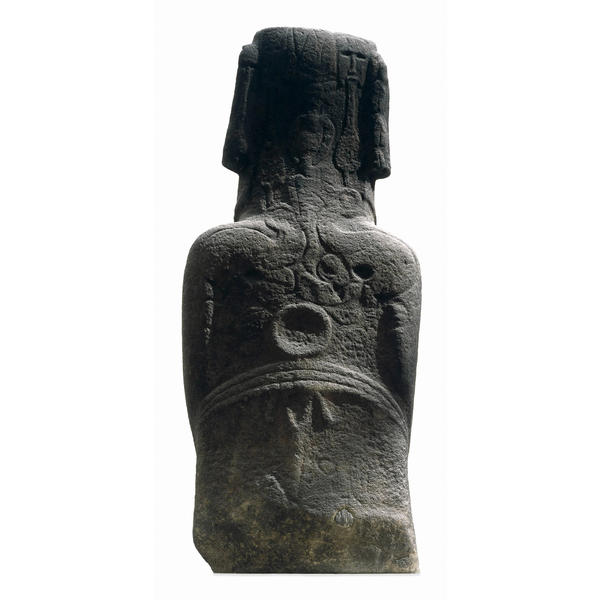
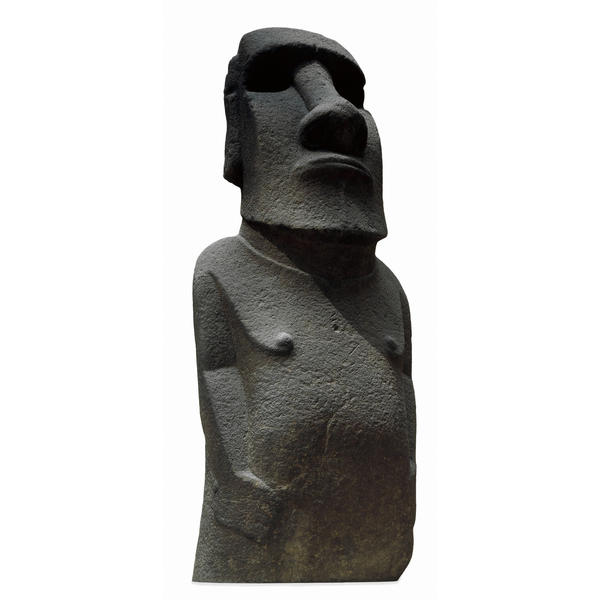
Above:
Hoa Hakananai'a, "Stolen Friend", now in British Museum. 2.4 metres tall. Taken to Britain 1868.
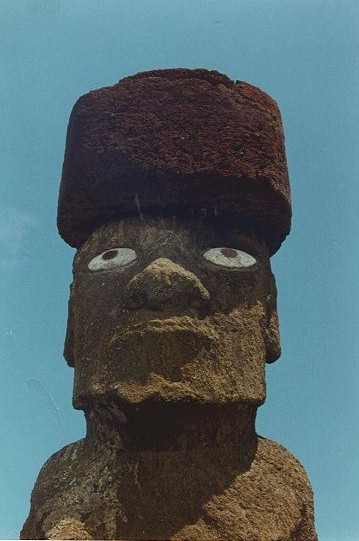
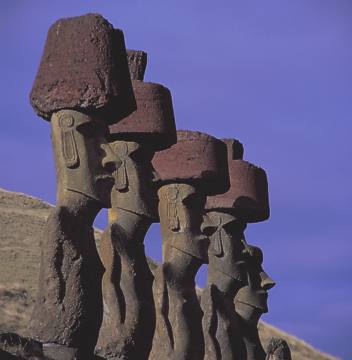
Originally, the moai had hats and eyes.
But these are recently re-erected.

Previous theories about how to move a moai:
http://www.pbs.org/wgbh/nova/easter/move/past.html
Illustrations of modern apparatus used to try moving moai: http://www.pbs.org/wgbh/nova/easter/move/ccdiag3.html
Record of recent attempts to move the moai: http://www.pbs.org/wgbh/nova/easter/textindex.html
Then the Moai were toppled... all of them.
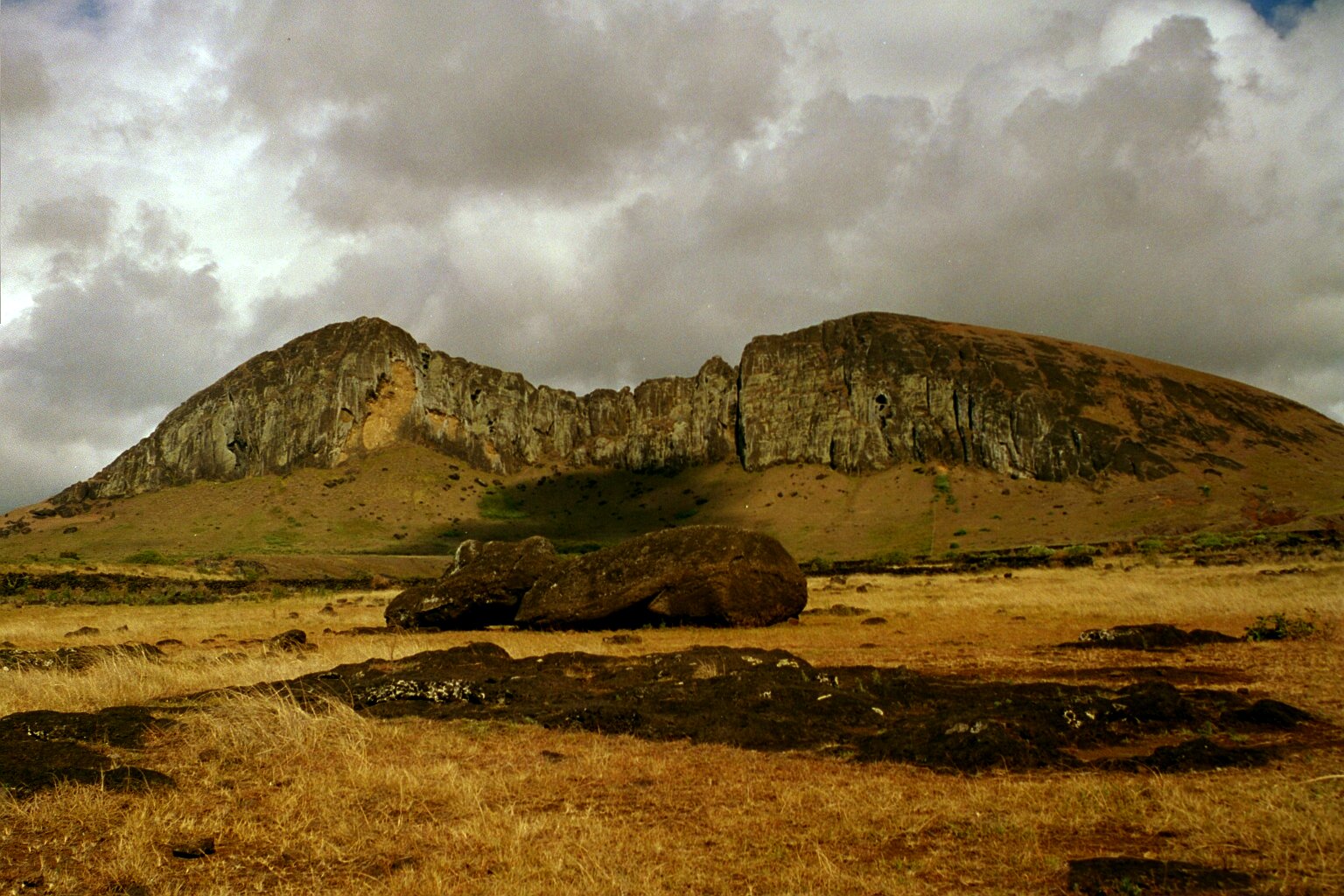
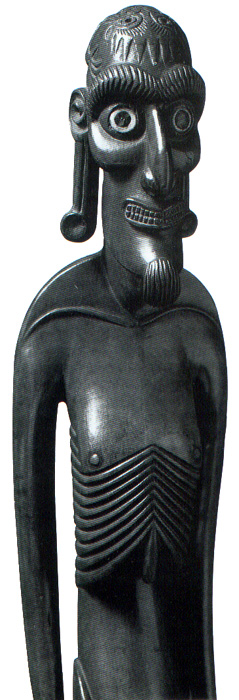
Life on Rapa Nui took a turn for the worse...
- Moai kavakava (right), wooden statuettes from the island, used to ward off evil spirits, indicate a familiarity with hunger (though their symbolism is complex)
- also clear evidence of an escalation in violence, including cannibalism
What went wrong?
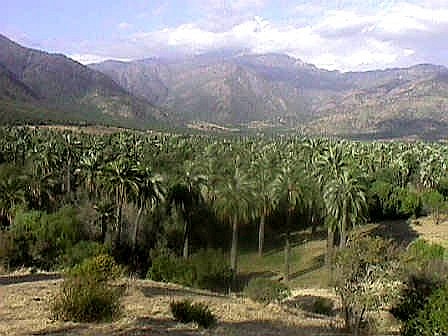
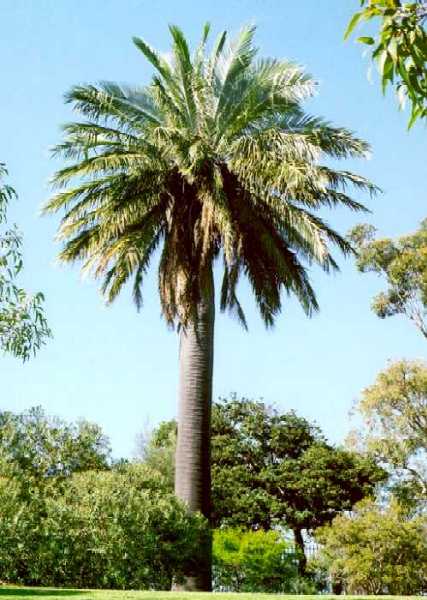
The Chilean Palm: Probably similar to the palm trees that once covered Easter Island.
How do we know about ancient vegetation on Easter Island?
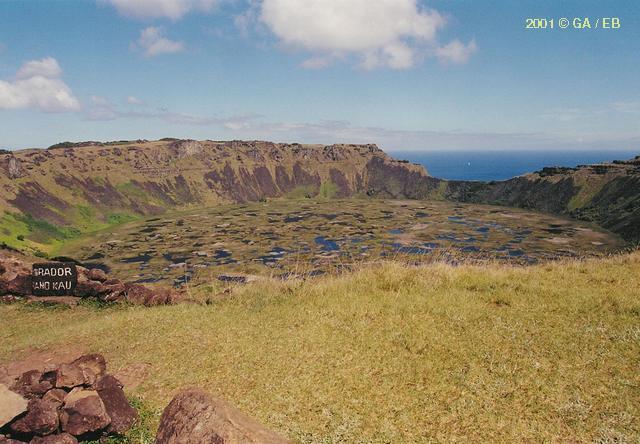
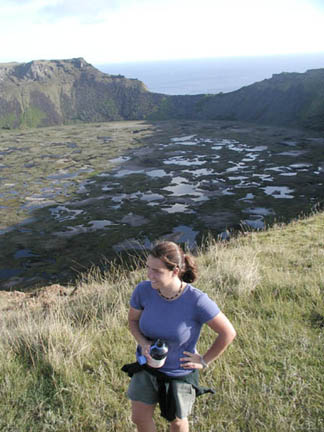
The Ranu Kao Crater: An excellent source of ancient pollen!
Pollen profile below from Bahn & Flenley's Easter Island, Earth Island.
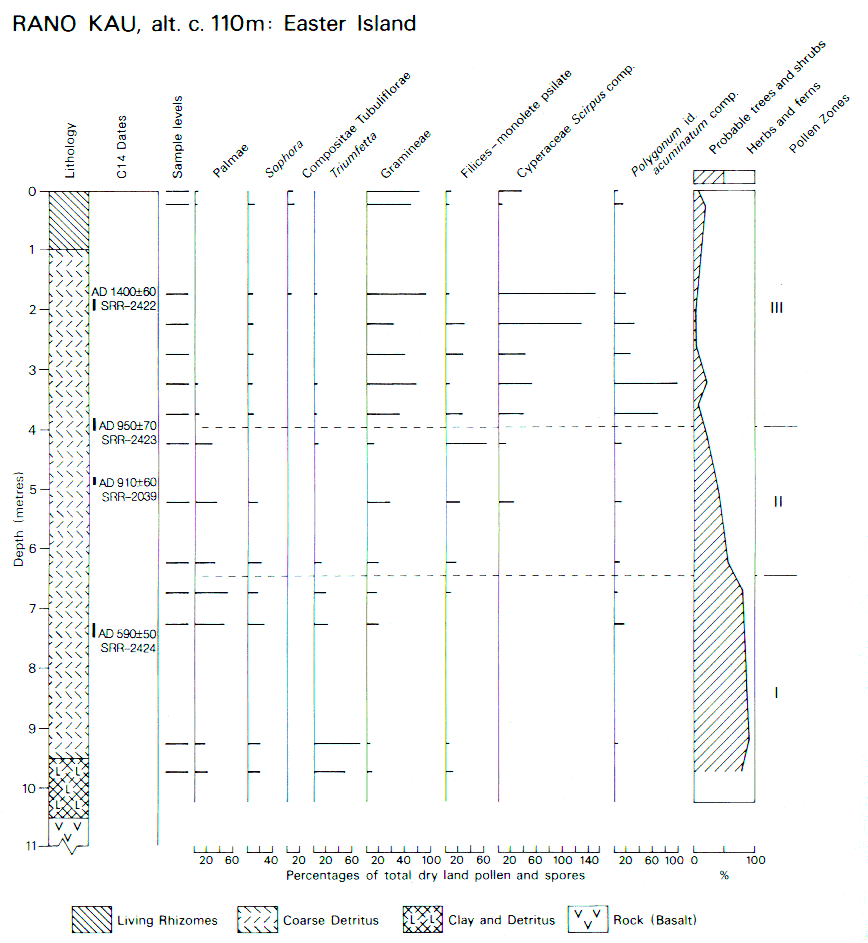
Pattern? Clear evidence of deforestation.
How? Why? Consequences?
Below: Rapa Nui today.
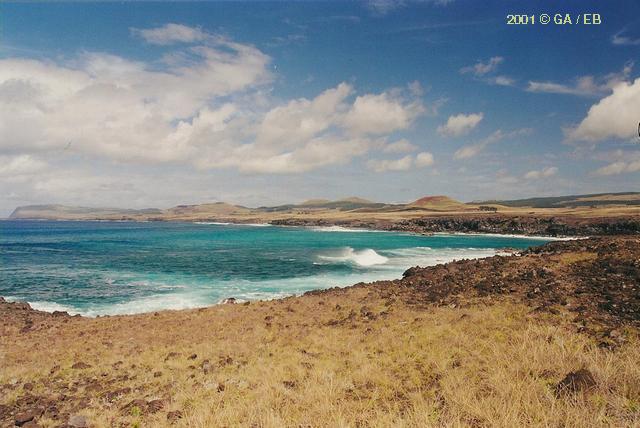
Below: Palm trees have been reintroduced on Rapa Nui.
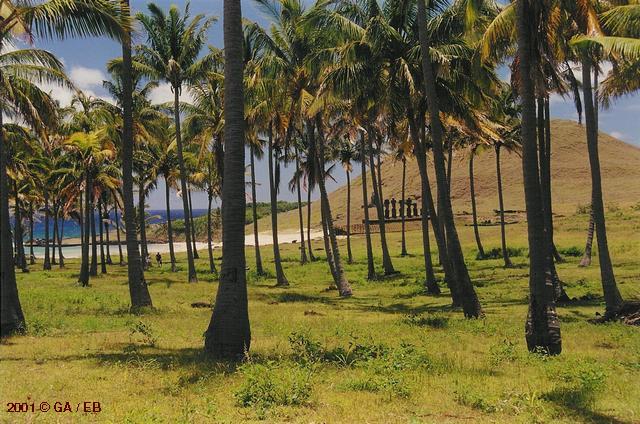
We'll return to Easter Island in a moment...
COLLAPSE
Archaeology was partly born of wondering... what went wrong? Why did these civilizations end?
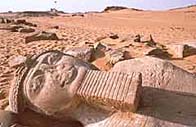
I MET a traveller from an
antique land
Who said:—Two vast and trunkless legs of stone
Stand in the desert. Near them on the sand,
Half sunk, a shatter'd visage lies, whose frown
And wrinkled lip and sneer of cold command
Tell that its sculptor well those passions read
Which yet survive, stamp'd on these lifeless things,
The hand that mock'd them and the heart that fed.
And on the pedestal these words appear:
"My name is Ozymandias, king of kings:
Look on my works, ye mighty, and despair!"
Nothing beside remains: round the decay
Of that colossal wreck, boundless and bare,
The lone and level sands stretch far away.
- P.B. Shelley, 1817
(Ramesses II, aka Ozymandias)
There are a lot of popular 'new age' books that deal with these questions of what past civilizations can teach us, e.g. The Mayan Prophecies (which foretells the end of our age in 2012... mark that in your calendar). These books usually don't have too much to do with the actual archaeology, though.
Strictly archaeologically speaking...
What is Societal Collapse?: abandonment of a region, replacement of one subsistence regime by another (e.g. agriculture being replaced by pastoralism), conversion to a lower energy socio-political organization (empire shifting down to a local state; state shifting down to dispersed chiefdoms).
How has it been explained?
For a while in archaeology, single-cause explanations were popular.
Then multicausal explanations became popular.
Then, for a while (around the year 2000), single-cause explanations of catastrophic collapses became popular again, as these parodies show:
Oh No! Godzilla’s Attacking Babylon!

www.archaeology.org/online/features/godzilla/
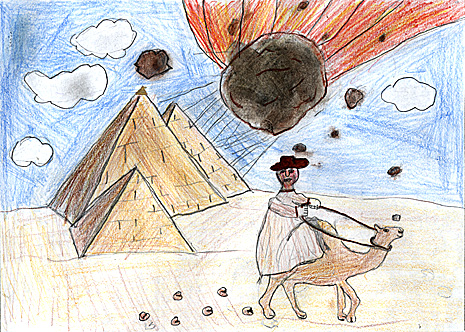
Catastrophes are real... but do they explain most collapses?
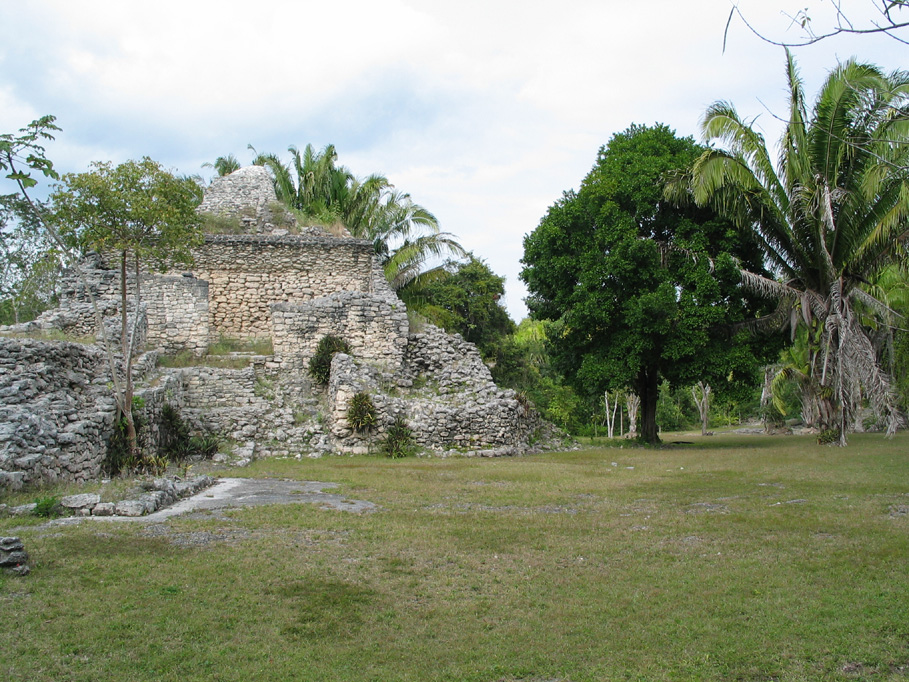
The Case of the Classic Maya: Shifting Explanations for Collapse
Recalling timeline: http://www.ancientmexico.com/content/timeline/
- politics? religion? war? ecology?
- theories have changed according to contemporary events, as well as because of new data
Recall, also, the case of the Norse in Greenland
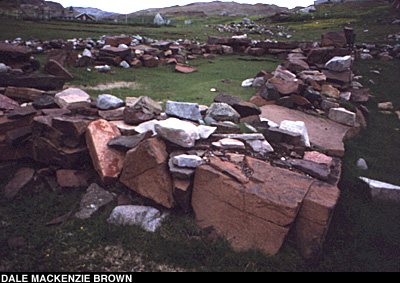
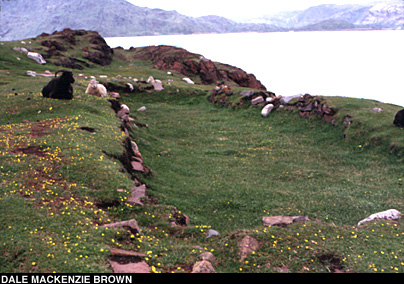
Left: Ruins of a small Norse church in Greenland. Image: http://www.archaeology.org/online/features/greenland/index.html
Right: Ruins of the Great Hall of the Western Settlement. Image: www.archaeology.org/online/features/greenland/index.html
Studying Climate Change and Societal Collapse in Prehistory
Palaeoclimate tracking methods have developed quickly in recent years, and have been used more widely than before. E.g. recovered pollen from archaeological sites OR from layers in the earth, lake sediments, or ice, corresponding to relevant dates, can be used to gauge vegetation and climate. Levels of dust in sediment can also indicate periods of drought. Tree-rings and coral can also be used. Palaeoclimate methods are the main method for understanding long range climate variation (i.e. drought patterns of multiple decades or centuries), other than using written history, which isn’t always available.
|
WHO/WHERE |
WHEN |
NATURE OF SOCIAL COLLAPSE |
CLIMATIC CORRELATION |
NOTES |
|
Natufian, SW Asia
|
around 12 000 Years Before Present |
abandoned seasonal H-G, moved to neighbouring region, switched to farming |
Cold, dry snap required food harvesting to become more intensive |
|
|
Late Uruk, Mesopotamia |
around 5 500 YBP |
sudden abandonment of complex settlements with irrigation agriculture |
200-year, severe drought |
in this area, the rise and fall of civilizations over several thousands of years correlates well to climatic events |
|
Akkadian, Harappan, others in Mediterranean, Egypt, W.Asia |
around 4200 YBP |
abrupt, widespread abandonment of inhabited regions, general collapse of empires |
catastrophic drought and cooling (reduction of precipitation over 30% in some areas) |
|
|
Moche, Peru |
around 1500 YBP |
abrupt abandonment and destruction of capital city, fields, widespread famine; relocation to the north |
30-year drought, cold snap,severe failure of irrigation |
Peruvian societies moved between coast and highlands over centuries according to climate |
|
Tiwanaku, Bolivia/Peru |
around 1000 BP |
general collapse of urban centres due to destruction of agricultural base; abrupt abandonment of cities end of 1500-year-old culture |
prolonged drought and cold snap destroyed irrigation agriculture |
|
|
Classic Maya, Mesoamerica |
around 1200 BP |
general collapse of all urban centres, violence, political instability, destruction of monumental architecture, regional abandonment, radical population decline |
prolonged, severe drought of about 200 years duration; also deforestation, erosion |
|
|
Norse, Greenland
|
around 800 BP |
famine, extinction of settlement |
20-year cold snap pushed their marginal economy over the edge |
n.b.. neighbouring Thule flourished during this time; different economy |
|
Anasazi, SW North Am |
around 700 BP |
warfare, profound political instability, regional abandonment, up to 75% depopulation, regional deforestation |
prolonged, severe drought (26 years) |
|
|
United States
|
1930s |
devastating agricultural, economic, social disaster; displacement of millions |
“Dust Bowl Drought” 1933-38, key factor in widespread economic collapse in 30s |
problem partly due to sharp decline in rain but also due to agricultural practices |
Explaining Collapse: earlier theories, which explained such change primarily in terms of politics and economics, didn’t consider ecology enough. Current information regarding societal collapse indicates that climate change is a key driver in processes of cultural collapse.
Jaren Diamond, in his book Collapse (2005) adds that cross-culturally and throughout history: the eight environmental causes for collapse are: “deforestation and habitat destruction, soil problems (erosion, salinization, and soil fertility losses), water management problems, overhunting, overfishing, effects of introduced species on native species, human population growth, and increased per-capita impact of people” (Diamond 2005:6). However, none of these challenges is in itself enough to induce collapse. Diamond specifies his five-point framework for understanding possible environmental collapses: “Four of those sets of factors – environmental damage, climate change, hostile neighbours, and friendly trade partners – may or may not prove significant for a particular society. The fifth set of factors – the society’s responses to its environmental problems – always proves significant” (Diamond 2005:11).
SO:
environmental damage
climate change
hostile neighbours
friendly trade partners (and changes in relations)
And most significant - society's response to its environmental problems.
Lessons?
Peter de Menocal: “Complex societies are neither powerless pawns nor infinitely adaptive to climate variability. As with modern cultures, the ancients adapted to and thrived in marginal climates with large interannual climate variability. As with ancient cultures, modern civilizations (regrettably) gauge their ability to adapt to future climate variations on the basis of what is known from historical (oral or instrumental) records. What differentiates these ancient cultures from our own is that they alone have witnessed the onset and persistence of unprecedented drought that continued for many decades to centuries. Efforts to understand past cultural responses to large and persistent climate changes may prove instructive for assessing modern societal preparedness for a changing and uncertain future.”
Weiss and Bradley: “We do, however, have distinct advantages over societies in the past because we can anticipate the future. Although far from perfect… [we have] a road map for how the climate system is likely to evolve in the future. We also know where population growth will be the greatest. We must use this information to design strategies that minimize the impact of climate change on societies that are at greatest risk. This will require substantial international cooperation, without which the 21st century will likely witness unprecedented social disruptions.”
Back to Easter Island ...
There are two ways to tell this story.
So... at some point, the last tree on Easter Island was cut down. The entire island had been deforested at that point, and the last trees were at the highest point... meaning, as has been said, that the person who cut down the last tree on Easter Island could see that it was the last tree, and they cut it down anyway.
But did they see?
Diamond suggests that perhaps they did not:
"Gradually trees became fewer, smaller, and less important. By the time the last fruit-bearing adult palm tree was cut, palms had long since ceased to be of economic significance. That left only smaller and smaller palm saplings to clear each year, along with other bushes and treelets. No one would have noticed the felling of the last small palm."
Implications of these different ways of telling the story?
Is it a story about deliberate evil?

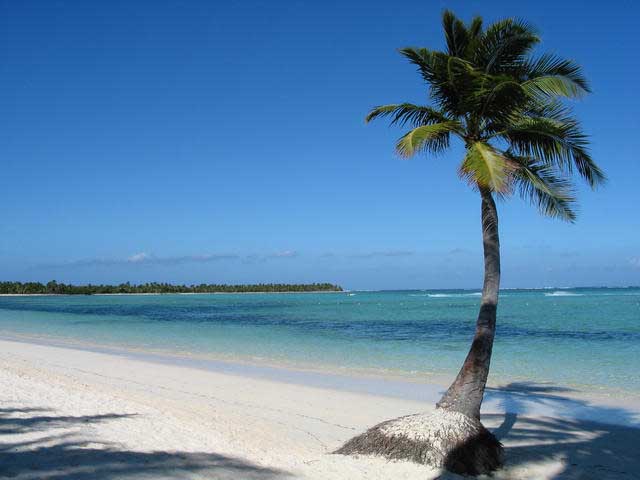
OR is it a story about ignorance and inattention?
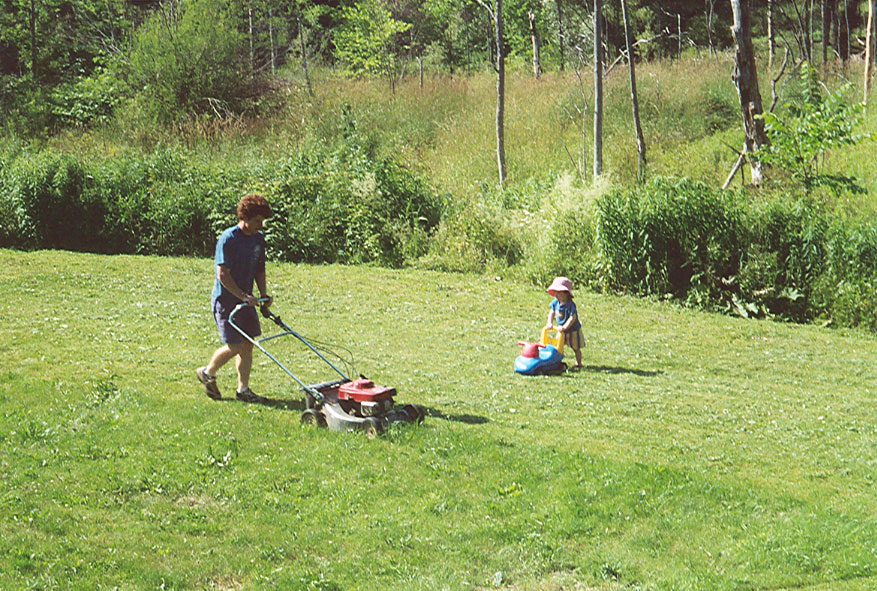
Bahn and Flenley on Easter Island:
"This is more, therefore, than an account of the rise and fall of an extraordinary prehistoric culture... it is, indeed, a cautionary tale relevant for the future of all humankind."
Ronald Wright, A Brief History of Progress, p 131-2
" The great advantage we have, our best chance for avoiding the fate of past societies, is that we know about those past societies. We can see how and why they went wrong. Homo sapiens has the information to know itself for what it is: an Ice Age hunter only half-evolved towards intelligence; clever but seldom wise.
We are now at the stage when the Easter Islanders could still have halted the senseless cutting and carving, could have gathered the last trees' seeds to plant out of reach of the rats. We have the tools and the means to share resources, clean up pollution, dispense basic health care and birth control, set economic limits in line with natural ones. If we don't do these things now, while we prosper, we will never be able to do them when times get hard. Our fate will twist in our hands. And this new century will not grow very old before we enter an age of chaos and collapse that will dwarf all the dark ages in our past.
Now is our last chance to get the future right."
What does history say: Is there hope?
Yes. There ARE complex societies who lived sustainably for many millennia (e.g. Papua New Guinea, Tikopia).
The point is not that we are just like the Norse, or just like the Maya, or just like the Mesopotamians, or just like the Egyptians, or just like the Papua New Guineans, or the Tikopians.
The point is that we are just like all of them. Our story includes all theirs. And we can learn.
The bottom line?
Archaeology puts us in touch with not only the lives and deaths of individual people, but of entire civilizations... and this can tell us much about our own lives and deaths as individuals, and our civilization's future.
It tells us that there are different ways to tell the story of humanity.
It tells us that the end hasn't been written yet.
It tells us of the choices we have.
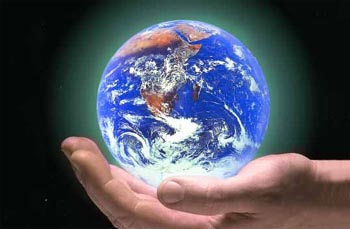
Choose to learn.
For
more, see:
Harvey Weiss and Raymond Bradley. 2001. “What Drives Societal Collapse?”
Science 291.
Charles Redman. 1999. Human Impact on Ancient Environments. Tucson: University
of Arizona Press.
Peter deMenocal. 2001. “Cultural Responses to Climate Change during the Late
Holocene.” Science 292 (27 April 2001)
Ronald Wright: A Brief History of Progress, and Stolen Continents
Jared Diamond: Collapse, and Guns, Germs and Steel, and The Third Chimpanzee
Paul Bahn and John Flenley: Earth Island, Easter Island
Jane Goodall: Reason for Hope